Diseño de un sistema de gestión sincrónica basado en órdenes de FMZ (2)
El autor:No lo sé., Creado: 2022-04-06 17:12:00, Actualizado: 2022-04-06 17:20:08Diseño de un sistema de gestión sincrónica basado en órdenes de FMZ (2)
Sistema de gestión sincrónica de pedidos (servidor sincrónico)
Continuemos la discusión en el artículo anterior:Diseño de un sistema de gestión sincrónica basado en órdenes FMZ (1), para diseñar una estrategia de supervisión de órdenes sincrónica. Por favor, considere las siguientes preguntas de diseño:
- 1.Si no desea supervisar sincrónicamente los pedidos durante un tiempo, ¿puede detenerse?Una vez que se detenga, desactive el reinicio desde la API extendida y use la verificación de contraseña.
Para implementar esta función, añadir 2 variables globales:
var isStopFollow = false // used to mark whether to currently supervise orders or not var reStartPwd = null // used to record the restart password

A continuación, añadir controles interactivos en la página de edición de la estrategia para detener / reiniciar la estrategia (no es para detener el bot, sólo para detener la lógica, para no seguir y supervisar las órdenes, sin hacer nada).Order Synchronous Management System Library (Single Server)Cuando se reinicie para supervisar órdenes, introduzca la contraseña preestablecida para invocar la función de supervisión de órdenes.
Código de ejecución de la función relacionada:
...
// Judge the interactive command
if (arr.length == 2) {
// Buttons with controls
if (arr[0] == "stop/restart") {
// Stop/restart to supervise orders
if (!isStopFollow) {
isStopFollow = true
reStartPwd = arr[1]
Log("stopped to supervise orders,", "the set restart password is:", reStartPwd, "#FF0000")
} else if (isStopFollow && arr[1] == reStartPwd) {
isStopFollow = false
reStartPwd = null
Log("restarted to supervise orders,", "clear the restart password.", "#FF0000")
} else if (isStopFollow && arr[1] != reStartPwd) {
Log("Wrong restart password!")
}
}
continue
}
- 2.El importe de la orden supervisada puede especificarse o ampliarse en función de la relación:

EspecifiedAmount: especificar el importe de la orden supervisada; el valor por defecto es -1, es decir, no especificado.
zoomAmountRatio: zoom de acuerdo con la cantidad ordenada en la señal enviada.ETH_USDT,swap,buy,1, luego multiplicar el valor de la cantidad de pedido por zoomAmountRatio; por defecto es -1, es decir, no se ha acercado.
var amount = specifiedAmount == -1 ? action.amount : specifiedAmount
amount = zoomAmountRatio == -1 ? amount : amount * zoomAmountRatio
En este sentido, hemos comprendido queel zoomel importe del pedido, oespecifique un cierto valor, según la señal recibida.
- 3.Escribe códigos lo más sencillos posible y utiliza otras bibliotecas de plantillas para gestionar los pedidos.
Biblioteca de plantillas utilizada para la colocación de órdenes al contado:https://www.fmz.com/strategy/10989Biblioteca de plantillas utilizada para la colocación de órdenes de futuros:https://www.fmz.com/strategy/203258
function trade(action) {
// Switch the trading pair, and set contract
exchange.SetCurrency(action.symbol)
if (action.ct != "spot") {
exchange.SetContractType(action.ct)
}
var retTrade = null
var amount = specifiedAmount == -1 ? action.amount : specifiedAmount
amount = zoomAmountRatio == -1 ? amount : amount * zoomAmountRatio
if (action.direction == "buy") {
retTrade = action.ct == "spot" ? $.Buy(amount) : $.OpenLong(exchange, action.ct, amount)
} else if (action.direction == "sell") {
retTrade = action.ct == "spot" ? $.Sell(amount) : $.OpenShort(exchange, action.ct, amount)
} else if (action.direction == "closebuy") {
retTrade = action.ct == "spot" ? $.Sell(amount) : $.CoverLong(exchange, action.ct, amount)
} else if (action.direction == "closesell") {
retTrade = action.ct == "spot" ? $.Buy(amount) : $.CoverShort(exchange, action.ct, amount)
}
return retTrade
}
Por lo tanto, se puede ver que para realizar un pedido sólo se necesita una declaración:$.Sell(amount), $.Buy(amount), $.OpenLong(exchange, action.ct, amount), etc.
Código de estrategia:
El código temporal en el anteriorOrder Synchronous Management System (Synchronous Server)es la siguiente:
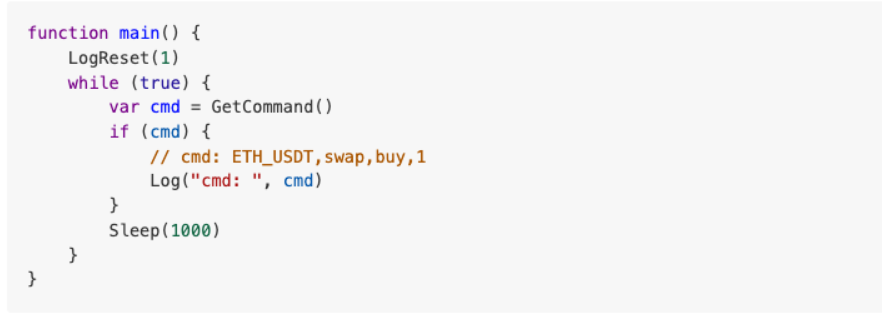
Ahora, vamos a diseñar elOrder Synchronous Management System (Synchronous Server)Una vez más:
// Global variables
var isStopFollow = false
var reStartPwd = null
function trade(action) {
// Switch the trading pair, and set contract
exchange.SetCurrency(action.symbol)
if (action.ct != "spot") {
exchange.SetContractType(action.ct)
}
var retTrade = null
var amount = specifiedAmount == -1 ? action.amount : specifiedAmount
amount = zoomAmountRatio == -1 ? amount : amount * zoomAmountRatio
if (action.direction == "buy") {
retTrade = action.ct == "spot" ? $.Buy(amount) : $.OpenLong(exchange, action.ct, amount)
} else if (action.direction == "sell") {
retTrade = action.ct == "spot" ? $.Sell(amount) : $.OpenShort(exchange, action.ct, amount)
} else if (action.direction == "closebuy") {
retTrade = action.ct == "spot" ? $.Sell(amount) : $.CoverLong(exchange, action.ct, amount)
} else if (action.direction == "closesell") {
retTrade = action.ct == "spot" ? $.Buy(amount) : $.CoverShort(exchange, action.ct, amount)
}
return retTrade
}
function parseCmd(cmd) {
var objAction = {}
// Parse cmd, such as: ETH_USDT,swap,buy,1
var arr = cmd.split(",")
if (arr.length != 4) {
return null
}
objAction.symbol = arr[0]
objAction.ct = arr[1]
objAction.direction = arr[2]
objAction.amount = arr[3]
return objAction
}
function main() {
// Clear all logs
LogReset(1)
if (isSimulateOKEX) {
exchange.IO("simulate", true)
Log("Switch to OKEX simulated bot!")
}
// set precision
exchange.SetPrecision(pricePrecision, amountPrecision)
// Check specifiedAmount and zoomAmountRatio, for they cannot be set at the same time
if (specifiedAmount != -1 && zoomAmountRatio != -1) {
throw "cannot set specifiedAmount and zoomAmountRatio at the same time"
}
while (true) {
var cmd = GetCommand()
if (cmd) {
Log("cmd: ", cmd)
var arr = cmd.split(":")
// Judge the interactive command
if (arr.length == 2) {
// Buttons with controls
if (arr[0] == "stop/restart") {
// Stop/restart to supervise orders
if (!isStopFollow) {
isStopFollow = true
reStartPwd = arr[1]
Log("stopped to supervise orders,", "the set restart password is:", reStartPwd, "#FF0000")
} else if (isStopFollow && arr[1] == reStartPwd) {
isStopFollow = false
reStartPwd = null
Log("restarted to supervise orders,", "Clear the restart password", "#FF0000")
} else if (isStopFollow && arr[1] != reStartPwd) {
Log("Wrong restart password!")
}
}
continue
}
// Allow to supervise orders
if (!isStopFollow) {
// Parse the interactive command of the order supervising signal
var objAction = parseCmd(cmd)
if (objAction) {
// Parse correctly
var ret = trade(objAction)
} else {
Log("Wrong signal cmd:", cmd)
}
}
}
// Display the order supervising status
LogStatus(_D(), isStopFollow ? "Stop synchronization" : "Maintain synchronization", "\n")
Sleep(1000)
}
}
Prueba
Esta vez, la prueba de tick real de Binance se utiliza para la cuenta con órdenes, y la cuenta OKEX se utiliza para el bot de supervisión de órdenes.mainLa función en elOrder Synchronous Management System Library (Single Server)el modelo).
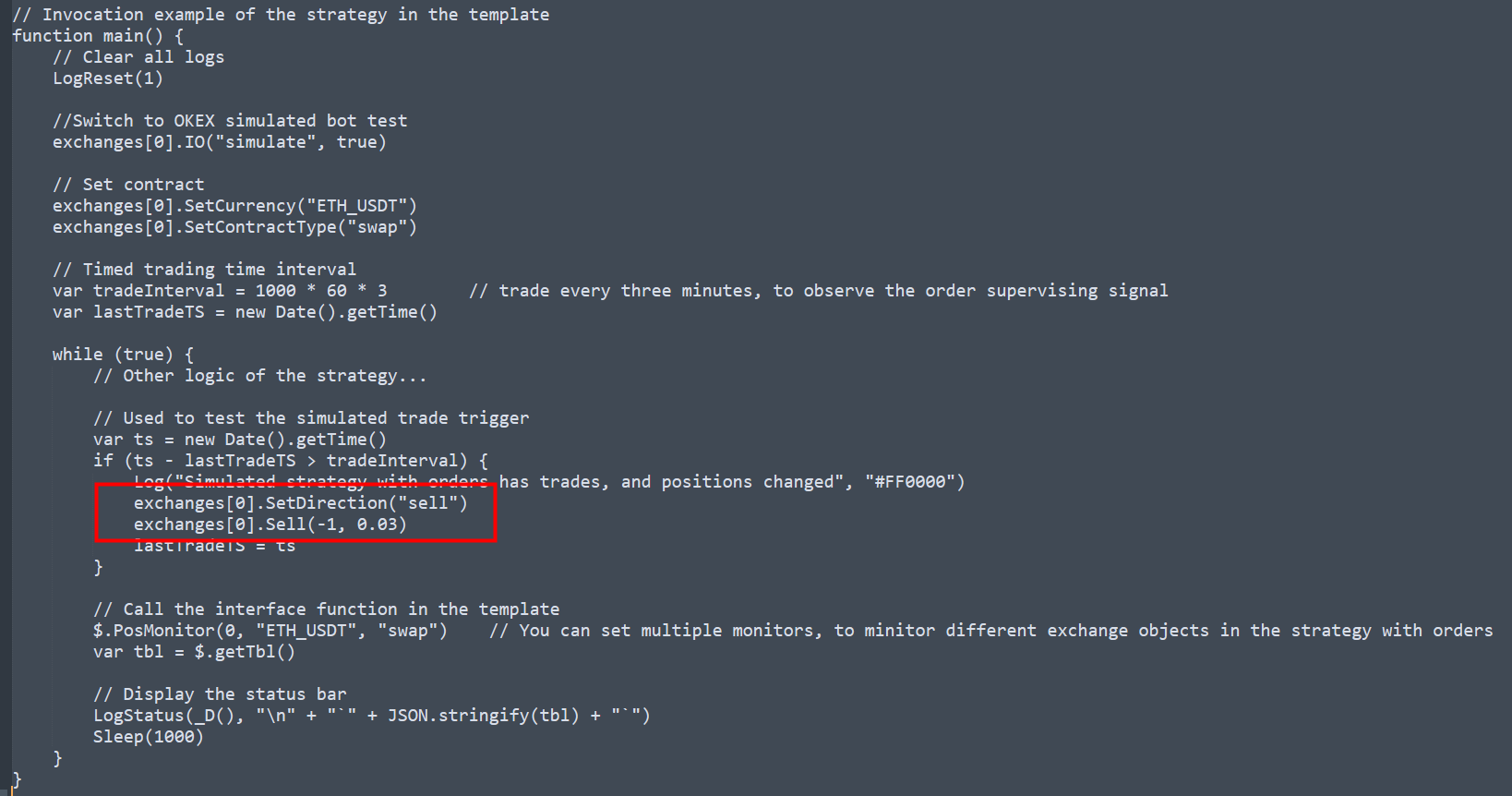
Es sólo que hemos cambiado la dirección de negociación a corto, y el volumen de negociación se cambió a 0.003 (Binance USDT-contratos de margen se pueden colocar en decimales). Sin embargo, la cuenta OKEX con órdenes debe ser un número entero (la orden colocada por OKEX debe ser un número entero), por lo que el parámetro que especifico el parámetro de la estrategiaspecifiedAmountcomo 1.

El bot de la función de prueba enOrder Synchronous Management System Library (Single Server)provocó el intercambio.
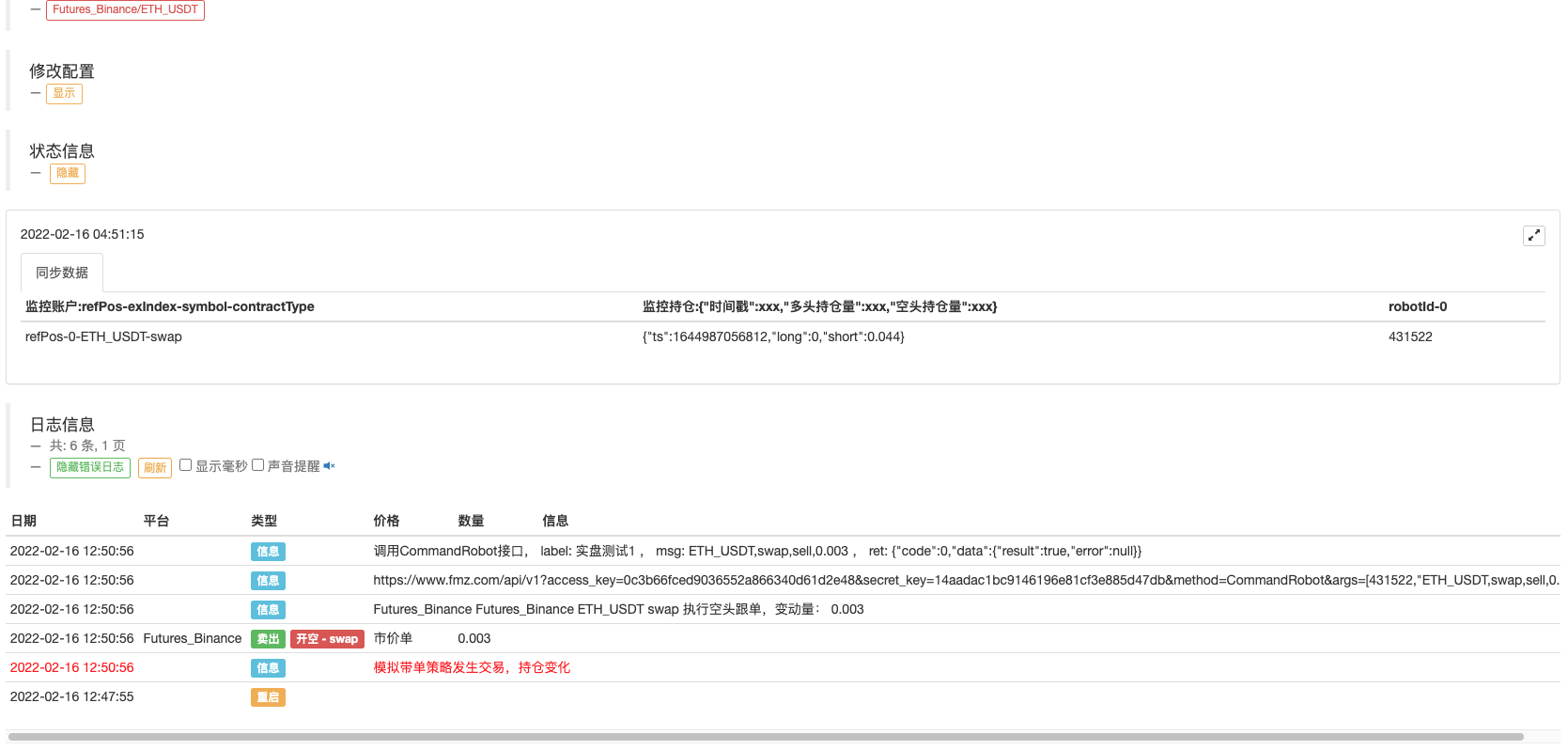
La orden de supervisión de la estrategia bot recibió la señal, y ejecutar la acción de supervisión:

La plataforma abrió el pedido correspondiente.

A continuación, pruebe las posiciones de cierre y cambie la dirección de la orden en la función principal para cerrar la posición corta, 0,003.
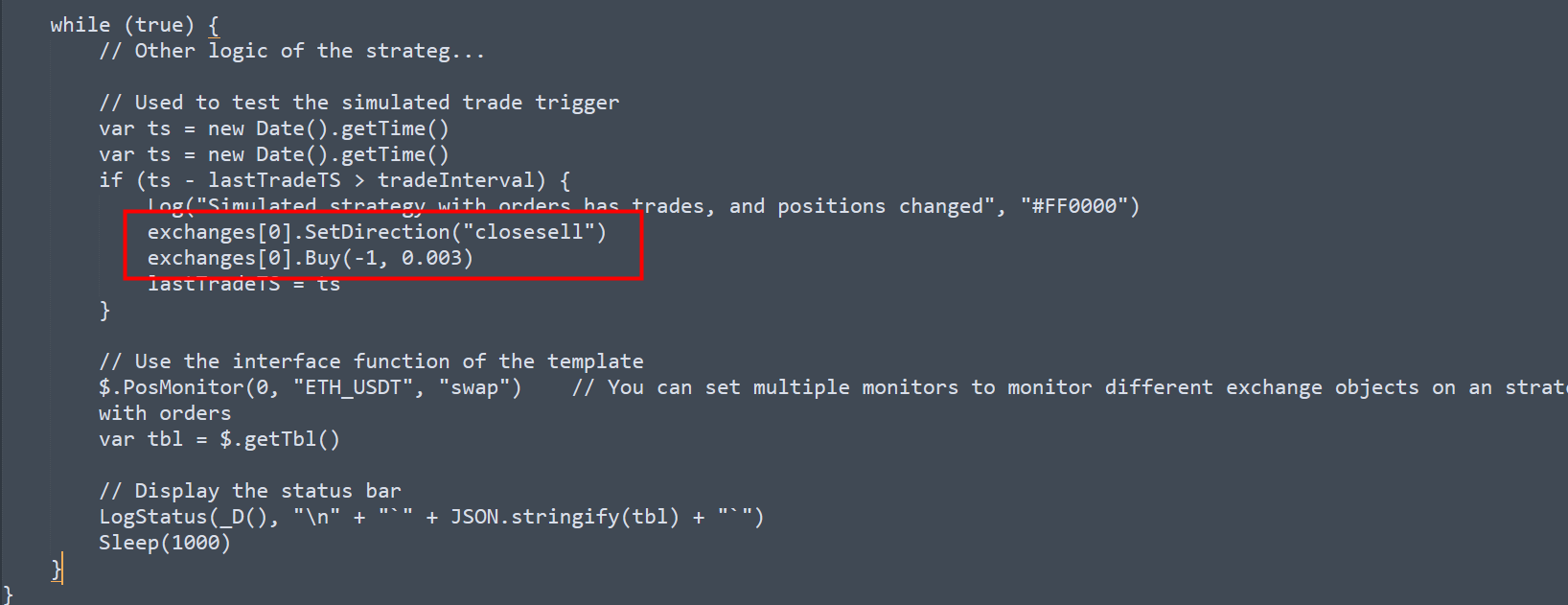
Luego reinicie el bot que es responsable de llevar órdenes (Order Synchronous Management System Library (Single Server)).
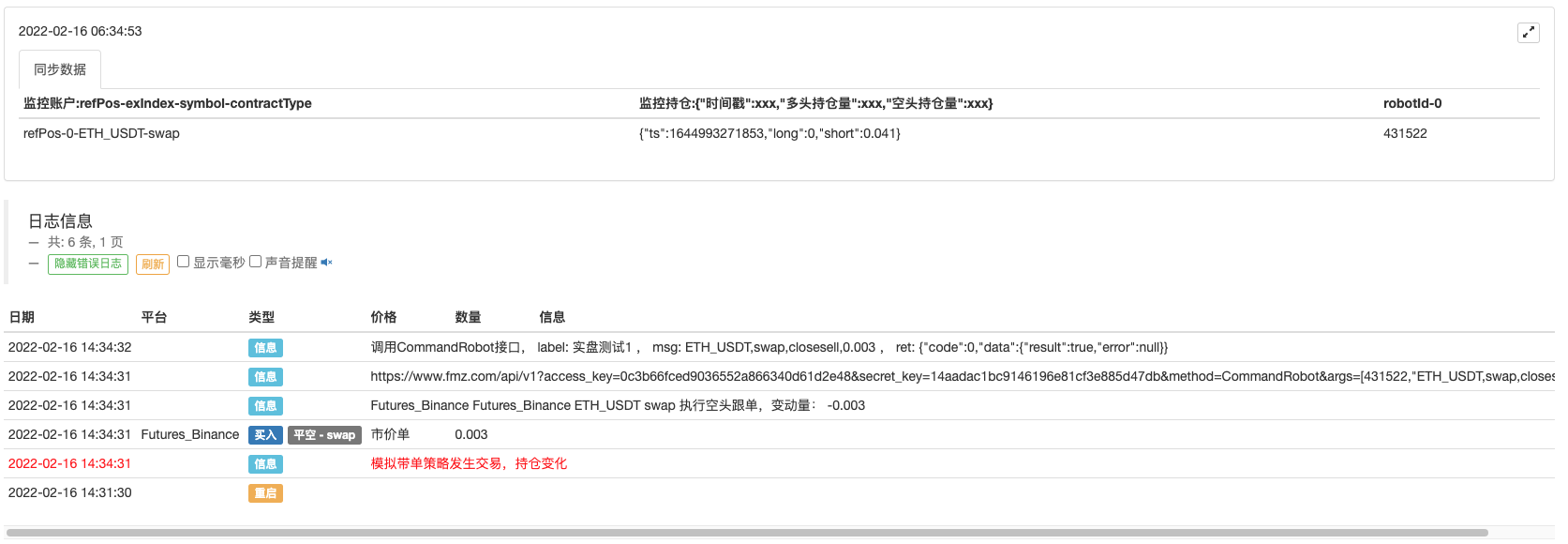
La misma operación también se activa en el bot de supervisión de orden:
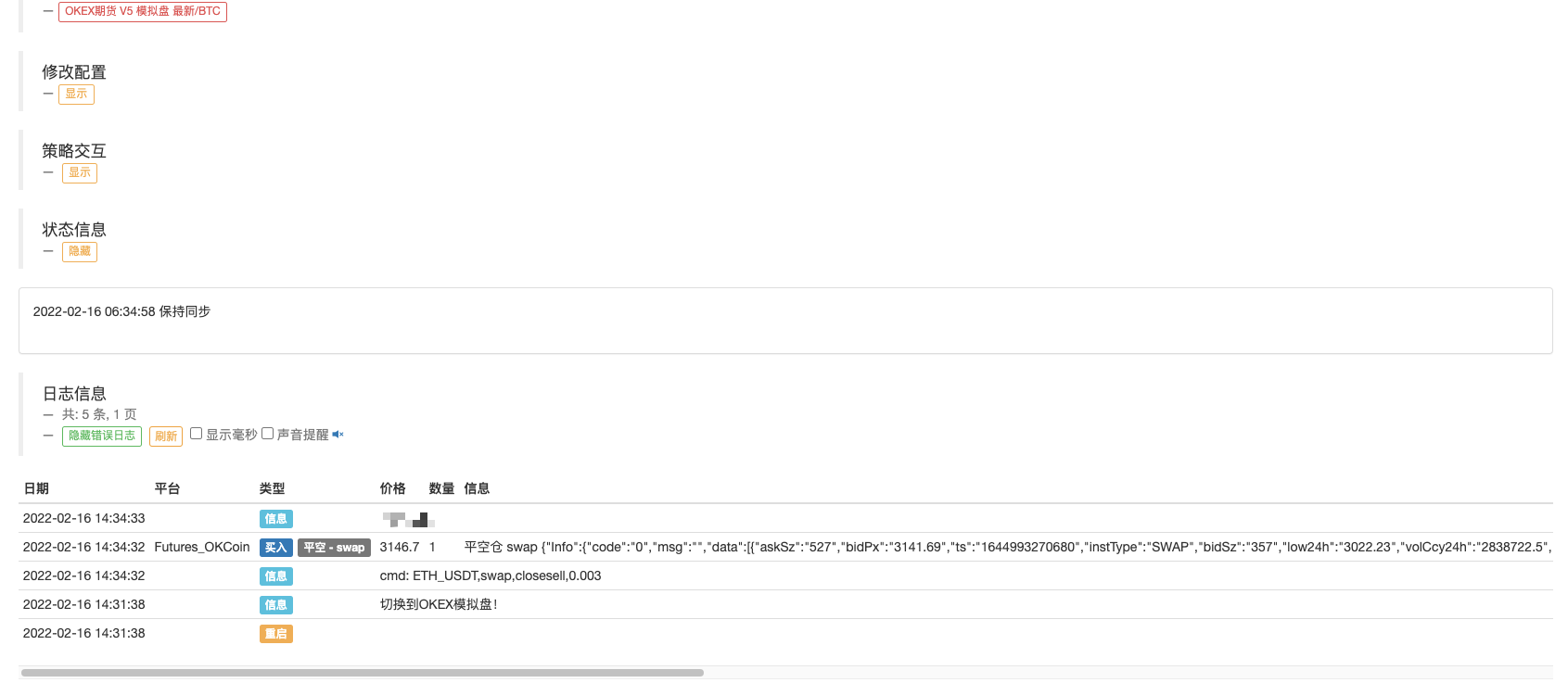
Dirección de la estrategia:Ordenar la biblioteca del sistema de gestión sincrónica (servidor único) Sistema de gestión sincrónica de pedidos (servidor sincrónico)
Esas estrategias sólo se utilizan para la comunicación y el estudio; para el uso real, usted necesita modificar, ajustar y optimizar por sí mismo.
- Investigación de diseño de estrategias de cobertura y ejemplo de órdenes de spot y futuros pendientes
- Situación reciente y funcionamiento recomendado de la estrategia de tasas de financiación
- Estrategia de punto de quiebre de promedio móvil doble de futuros de criptomonedas (Teaching)
- Estrategia de media móvil doble de símbolos múltiples de criptomoneda al contado (Teaching)
- Realización del indicador de Fisher en JavaScript y trazado en FMZ
- El administrador
- Revisión del TAQ de criptomonedas 2021 y estrategia perdida más simple de aumento de 10 veces
- Estrategia ART de futuros de criptomonedas de símbolos múltiples (Enseñanza)
- ¡Actualice! Estrategia de futuros de criptomonedas Martingale
- La función Getrecords no puede obtener el gráfico de K en segundos
- Los datos de volumen que Getticker ha devuelto no son correctos.
- Diseño de un sistema de gestión sincrónica basado en órdenes FMZ (1)
- Diseñar una biblioteca de gráficos múltiples
- Entorno de disco
- Código de 60 líneas realizando un pensamiento - Pesca de fondo de contrato
- Anuncio de actualización y ajuste del sistema de facturación FMZ
- Aviso para las estrategias de escritura fantasma en FMZ
- El servidor superior está terminando su tiempo de servicio.
- Binance reportó un error en el pedido
- Variedad